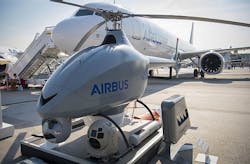Army reaches out to industry for prototype unmanned cargo aircraft to move military supplies
Officials of the Army Contracting Command in Warren, Mich., announced plans Wednesday to issue a request for prototype proposals (UASRPP18-10) for a medium-size UAV able to move supplies quickly to and from the battlefield.
The Army Contracting Command is issuing this request for prototypes on behalf of the Army Armament Research Development, and Engineering Center (ARDEC) headquartered at Picatinny Arsenal, N.J.
Army experts want a UAV prototype able to carry a payload of between 50 and 600 pounds of supplies while maintaining a gross take off vehicle weight of less than 1320 pounds. This project is part of the Autonomous Unmanned Aerial Systems (UAS) program of record under the Ground Vehicle Systems Other Transaction Agreement (GVS OTA), W15QKN-17-9-1025.
The prototype could be roughly similar to an Airbus VSR700 rotary-wing UAV. Army experts will tailor the finished resupply UAV prototype to different capabilities to study its capabilities across several echelons of sustainment operations.
Related: Aurora moves forward with project to develop unmanned helicopter for battlefield resupply
The Airbus VSR700 helicopter UAV has a maximum takeoff weight of 1,543 pounds, and empty weight of 882 pounds, and can carry as much as 661 pounds of fuel and cargo. It can fly as fast as 100 knots, as high as 13,123 feet, and has a maximum range of 435 miles.
Prototype must integrate with traditional Army ground units. Several prototypes are required such that the Army can demonstrate basic swarming concepts. The UAV may be powered by batteries or fuel engines. The primary focus is assessing the influence of these types of systems on the supply chain.
The system should be able to travel a tactically relevant distance with vehicle size and weight as small as a possible to reduce logistical burden of transporting the platform around the battlefield. The UAV should have at least a basic level of flight system machine autonomy for take-off, landing, and waypoint navigation. There will be no follow-on production contract.
The Army will issue a formal request for proposals to the National Advanced Mobility Consortium (NAMC) in Ann Arbor, Mich. Information on the NAMC and/or how to become a member is online at www.defensemobility.org.
More information is online at https://www.fbo.gov/notices/48bbed1127df86e533c6ca7a85a27b21, or the National Advanced Mobility Consortium at www.namconsortium.org.
Ready to make a purchase? Search the Military & Aerospace Electronics Buyer's Guide for companies, new products, press releases, and videos
